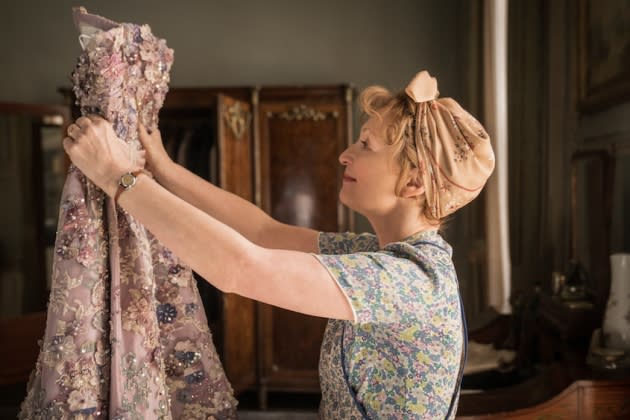‘Mrs. Harris Goes to Paris’ Review: How Far Would You Go for the Perfect Dior Dress?

For those tired of movies in which something as grand as the fate of our existence is at stake — threatened by aliens or wizards or something so far removed from reality — the simply titled and even more simply plotted “Mrs. Harris Goes to Paris” offers a pleasant reprieve. Here, in a fresh adaptation of Paul Gallico’s 1958 novel, we get an arm’s-reach fairy tale about an indefatigably chipper English charwoman whose most ardent dream is to own a gown from Christian Dior (a designer whose name she naively — but not un-endearingly — mispronounces, much the way Nomi speaks of her new “Versayce” in “Showgirls”).
Mrs. Harris’ goal may not seem so far-fetched, but it can only be realized by stepping out of her comfort zone, which means saving up her pennies and making a trip across the Channel to the land of Chanel, where dresses are made to order and what she craves is pronounced “Creest-yon Dee-yor.” This is 1957 we’re talking about, and the most exclusive French fashion houses don’t sell to just anyone — and certainly not to a client as common as this working-class war widow, so modestly embodied by frequent Mike Leigh collaborator Lesley Manville (“Another Year”).
More from Variety
In Paul Thomas Anderson’s fashion-world power drama “Phantom Thread,” Manville shone at the opposite end of the snobbery spectrum, playing Daniel Day-Lewis’ taskmaster sister — the tough, invisible woman behind the great man, as it were. Now, she’s up against just that sort of person in Mme. Colbert, the cold and condescending director of the House of Dior, played by big-screen ice queen Isabelle Huppert. “A Christian Dior gown is not for pennies,” Mme. Colbert huffs when Mrs. Harris shows up, looking clueless and slightly disheveled, at 30 avenue Montaigne.
Evidently, it wasn’t enough to come up with the funds — though Mrs. Harris’ unconventional process for doing so drives the perky first act of this featherweight adaptation from director Anthony Fabian. (Gallico’s thin but well-liked book previously spawned three sequels, a 1992 TV movie starring Angela Lansbury in the title role and a 2016 stage musical, “Flowers for Mrs. Harris.”) In the film’s fanciful way, Mrs. Harris must add winning over Mme. Colbert to the list of hurdles she must clear before acquiring a wearable work of art. Fortunately for her, nearly everyone else Mrs. Harris meets in Paris — from the affable winos at Gare du Nord to the romantically inclined Marquis de Chassagne (Lambert Wilson) — finds her just delightful.
Manville makes her so, playing Mrs. Harris as a good-natured woman who believes in luck and kindness, but also in a kind of socialist equality. “My money’s as good as anybody’s,” she insists, organizing the underappreciated artisans who actually make Dior’s dresses into an impromptu labor strike for the film’s loony climax. This finale doesn’t really work, nor does the movie’s feel-good epilogue, in which we finally see Mrs. Harris wearing Dior: While Manville is hardly frowsy, the “frock” — as Mrs. Harris refers to the more alluringly named “Temptation” gown — doesn’t have nearly the same effect on her that it did on Dior’s top model, Natasha (Alba Baptista, a gorgeous Portuguese actor whose classic appeal suggests a cross between Audrey Hepburn and Alicia Vikander).
This may be Mrs. Harris’ princess fantasy, set in a “Funny Face”-era evocation of midcentury Paris (much of it doubled on the streets of Budapest), but that whimsical spirit doesn’t seduce audiences so much as it excuses the too-convenient plotting and largely one-dimensional characterizations. Fabian’s film is charming enough, though his attempts at romance remain earthbound as he makes a clean break from the TV version, offering a different interpretation of the character.
Much as Lansbury’s Broadway version of “Mame” had nothing to do with the earlier Rosalind Russell incarnation, Manville borrows nothing from Lansbury’s performance. Manville plays Mrs. Harris as a pragmatic but also superstitious woman. She gambles on dog races and believes that her late husband has sent her on a mission to find love. Could this be her chance? Frankly, it’s more interesting to watch how Mrs. Harris inspires others, as when she encourages the budding attraction between Natasha and Dior’s awkward accountant, André (Lucas Bravo, of obvious influence “Emily in Paris”), who share an interest in Sartre’s existentialist tract “Being and Nothingness.”
For the most part, Fabian and his three co-writers (which seems rather a lot for so slight a project) have done well to boost the intellect and assertiveness of the novel’s female characters. Still, we’re miles behind the punk-infused empowerment anthem that was last year’s “Cruella.” By contrast, “Mrs. Harris Goes to Paris” aims to please an older and decidedly more conservative demographic, dazzling them with a vintage Dior défilé: the 10th anniversary collection, handsomely re-created/re-imagined by “Cruella” costume designer Jenny Beavan.
The movie wouldn’t have been possible without Dior’s buy-in, which could explain scenes in which dresses are over-ripely described as a “poem” or a “moonbeam.” (Worth noting: Christian Dior died in 1957, and there’s no mention of Yves Saint Laurent, the prodigy who succeeded him.) Sure, there’s magic in watching a fashion masterpiece come together, though the movie ignores all the care that goes into custom-tailoring it to Mrs. Harris’ body when she gets home and loans the garment to a character with a completely different figure. One size does not fit all, no matter how much this winsome movie wishes that were so.
Best of Variety
Sign up for Variety’s Newsletter. For the latest news, follow us on Facebook, Twitter, and Instagram.